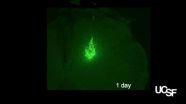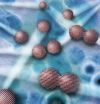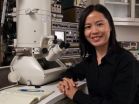(Press-News.org) A seaweed considered a threat to the healthy growth of coral reefs in Hawaii may possess the ability to produce substances that could one day treat human diseases, a new study led by scientists at Scripps Institution of Oceanography at UC San Diego has revealed.
An analysis led by Hyukjae Choi, a postdoctoral researcher in William Gerwick's laboratory at Scripps, has shown that the seaweed, a tiny photosynthetic organism known as a "cyanobacterium," produces chemical compounds that exhibit promise as anti-inflammatory agents and in combatting bacterial infections. The study is published in the May 25th issue of the journal Chemistry & Biology.
"In different arenas these compounds could be helpful, such as treating chronic inflammatory conditions for which we currently don't have really good medicines," said Gerwick, a professor of oceanography and pharmaceutical sciences at the Center for Marine Biotechnology and Biomedicine at Scripps and UC San Diego Skaggs School of Pharmacy and Pharmaceutical Sciences.
Scientists identified the "nuisance" organism in 2008 on the reefs directly adjacent to the National Park Pu'uhonua o H'onaunau off the Kona coast of Hawaii. The cyanobacterium is believed to be native to Hawaii and is usually inconspicuous, said Jennifer Smith, a Scripps assistant professor in the Scripps Center for Marine Biodiversity and Conservation and a paper coauthor.
"When we first found the bloom during routine surveys with the University of Hawaii we were concerned as it was clearly smothering the corals at one of the most popular dive sites in Hawaii," said Smith. "Observations in the field even suggested that the cyanobacteria may have been releasing some chemical that was causing the coral to bleach."
When Smith and her colleagues found the seaweed blooming it was clear that it was overgrowing and negatively affecting the underlying corals. Samples were retrieved in 2009 and transferred to Scripps for analysis.
Choi, Gerwick and their colleagues conducted various laboratory experiments and discovered that the seaweed (the cyanobacterium Leptolyngbya crossbyana) generates natural products known as honaucins with potent anti-inflammation and bacteria-controlling properties.
Specifically, the substances hamper bacteria's ability to "swarm" over surfaces. For example, when overtaking a new area, bacteria secrete small amounts of a substance known as a quorum sensing factor, which tests to see if the new surface is safe for colonization. Halting a quorum sensing factor could one day translate to a treatment for bacterial infections. For instance, this could be critical, Gerwick said, in the development of drugs to prevent infection in patients who require catheters to deliver vital nutrients to key areas such as arteries, as well the development of new treatments for acne and other skin conditions.
"I think this finding is a nice illustration of how we need to look more deeply in our environment because even nuisance pests, as it turns out, are not just pests," said Gerwick. "It's a long road to go from this early-stage discovery to application in the clinic but it's the only road if we want new and more efficacious medicines."
"These organisms have been on the planet for millions of years and so it is not surprising that they have evolved numerous strategies for competing with neighboring species, including chemical warfare," said Smith. "Several species of cyanobacteria and algae are known to produce novel compounds, many that have promising use in drug development for human and other uses."
### Other coauthors of the paper include Samantha Mascuch, Francisco Villa, Tara Byrum and Lena Gerwick of Scripps Institution of Oceanography; Margaret Teasdale and David Rowley of the University of Rhode Island; and Linda Preskitt of the University of Hawaii, Manoa.
UC San Diego and the National Institutes of Health supported the research.
Nuisance seaweed found to produce compounds with biomedical potential
Scripps-led analysis of tiny marine organisms indicates early promise in areas ranging from inflammation to skin conditions
2012-05-28
ELSE PRESS RELEASES FROM THIS DATE:
Chronic pain is relieved by cell transplantation in lab study
2012-05-28
Chronic pain, by definition, is difficult to manage, but a new study by UCSF scientists shows how a cell therapy might one day be used not only to quell some common types of persistent and difficult-to-treat pain, but also to cure the conditions that give rise to them.
The researchers, working with mice, focused on treating chronic pain that arises from nerve injury -- so-called neuropathic pain.
In their study, published in the March 24, 2012 issue of Neuron, the scientists transplanted immature embryonic nerve cells that arise in the brain during development and ...
Gourmet butterflies speed north
2012-05-28
A new study led by scientists in the Department of Biology at the University of York has shown how a butterfly has changed its diet, and consequently has sped northwards in response to climate change.
Their study is published in the latest issue of Science.
The researchers found that warmer summers have allowed the Brown Argus butterfly to complete its life cycle by eating wild Geranium plants. Because the Geraniums are widespread in the British countryside, this change in diet has allowed the butterfly to expand its range in Britain at a surprisingly rapid rate. Over ...
The cells' petrol pump is finally identified
2012-05-28
Our cells breathe and digest, as does the organism as a whole. They indeed use oxygen to draw the energy contained in the nutrients they ingest, before discarding the waste, as carbon dioxide and water. Glucose is a preferred nutrient for the cells. Its digestion occurs in the cytoplasm, in the absence of oxygen, and leads to the formation of pyruvate and a small amount of energy. Pyruvate is then carried into mitochondria, the cell's power plants, for a complete burning, thus providing a maximal energetic yield.
A mediocre energetic yield in tumor cells
'As opposed ...
CWRU class earns Science magazine prize for innovation
2012-05-28
Science magazine has awarded a prize for Inquiry-Based Instruction to a Case Western Reserve University class that melds biology, computer modeling, mathematical analysis and writing.
"Dynamics of Biological Systems," taught by Biology Professor Hillel Chiel and three graduate assistants, abandons traditional lectures altogether in favor of learning by doing. The teachers call the class an example of the use of the continual improvement model in education.
In it, Chiel pairs biology majors with engineering, physics or math majors, and has them concentrate on building ...
First direct observation of oriented attachment in nanocrystal growth
2012-05-28
Through biomineralization, nature is able to produce such engineering marvels as mother of pearl, or nacre, the inner lining of abalone shells renowned for both its iridescent beauty and amazing toughness. Key to biomineralization is the phenomenon known as "oriented attachment," whereby adjacent nanoparticles connect with one another in a common crystallographic orientation. While the importance of oriented attachment to biomineral properties long has been recognized, the mechanism by which it occurs has remained a mystery. With a better understanding of oriented attachment ...
Nanoparticles seen as artificial atoms
2012-05-28
VIDEO:
Berkeley Lab researchers at the National Center for Electron Microscopy recorded real-time observations of nanocrystal growth that support the theory of nanoparticles acting like artificial atoms. This electron microscopy movie...
Click here for more information.
In the growth of crystals, do nanoparticles act as "artificial atoms" forming molecular-type building blocks that can assemble into complex structures? This is the contention of a major but controversial ...
Knowing genetic makeup may not significantly improve disease risk prediction
2012-05-28
Boston, MA —Harvard School of Public Health (HSPH) researchers have found that detailed knowledge about your genetic makeup—the interplay between genetic variants and other genetic variants, or between genetic variants and environmental risk factors—may only change your estimated disease prediction risk for three common diseases by a few percentage points, which is typically not enough to make a difference in prevention or treatment plans. It is the first study to revisit claims in previous research that including such information in risk models would eventually help doctors ...
Pivotal role for proteins -- from helping turn carbs into energy to causing devastating disease
2012-05-28
(SALT LAKE CITY)—Research into how carbohydrates are converted into energy has led to a surprising discovery with implications for the treatment of a perplexing and potentially fatal neuromuscular disorder and possibly even cancer and heart disease.
Until this study, the cause of this neuromuscular disorder was unknown. But after obtaining DNA from three families with members who have the disorder, a team led by University of Utah scientists Jared Rutter, Ph.D., associate professor of biochemistry and Carl Thummel, Ph.D., professor of human genetics, sequenced two genes ...
Discarded data may hold the key to a sharper view of molecules
2012-05-28
CORVALLIS, Ore. — There's nothing like a new pair of eyeglasses to bring fine details into sharp relief. For scientists who study the large molecules of life from proteins to DNA, the equivalent of new lenses have come in the form of an advanced method for analyzing data from X-ray crystallography experiments.
The findings, just published in the journal Science, could lead to new understanding of the molecules that drive processes in biology, medical diagnostics, nanotechnology and other fields.
Like dentists who use X-rays to find tooth decay, scientists use X-rays ...
No new neurons in the human olfactory bulb
2012-05-28
Research from Karolinska Institutet in Sweden shows that the human olfactory bulb – a structure in the brain that processes sensory input from the nose – differs from that of other mammals in that no new neurons are formed in this area after birth. The discovery, which is published in the scientific journal Neuron, is based on the age-determination of the cells using the carbon-14 method, and might explain why the human sense of smell is normally much worse than that of other animals.
"I've never been so astonished by a scientific discovery," says lead investigator Jonas ...
LAST 30 PRESS RELEASES:
Low daily alcohol intake linked to 50% heightened mouth cancer risk in India
American Meteorological Society announces Rick Spinrad as 2026 President-Elect
Biomass-based carbon capture spotlighted in newly released global climate webinar recording
Illuminating invisible nano pollutants: advanced bioimaging tracks the full journey of emerging nanoscale contaminants in living systems
How does age affect recovery from spinal cord injury?
Novel AI tool offers prognosis for patients with head and neck cancer
Fathers’ microplastic exposure tied to their children’s metabolic problems
Research validates laboratory model for studying high-grade serous ovarian cancer
SIR 2026 delivers transformative breakthroughs in minimally invasive medicine to improve patient care
Stem Cell Reports most downloaded papers of 2025 highlight the breadth and impact of stem cell research
Oxford-led study estimates NHS spends around 3% of its primary and secondary care budget on the health impacts of heat and cold in England
A researcher’s long quest leads to a smart composite breakthrough
Urban wild bees act as “microbial sensors” of city health.
New study finds where you live affects recovery after a hip fracture
Forecasting the impact of fully automated vehicle adoption on US road traffic injuries
Alcohol-related hospitalizations from 2016 to 2022
Semaglutide and hospitalizations in patients with obesity and established cardiovascular disease
Researchers ‘listen in’ to embryo-mother interactions during implantation using a culture system replicating the womb lining
How changing your diet could help save the world
How to make AI truly scalable and reliable for real-time traffic assignment?
Beyond fragmented markets: A new framework for efficient and stable ride-pooling
Can shape priors make road perception more reliable for autonomous driving?
AI tracks nearly 100 years of aging research, revealing key trends and gaps
Innovative techniques enable Italy’s first imaging of individual trapped atoms
KIER successfully develops Korea-made “calibration thermoelectric module” for measuring thermoelectric device performance
Diversifying US Midwest farming for stability and resilience
Emphasizing immigrants’ deservingness shifts attitudes
Japanese eels, climate change, and river temperature
Pusan National University researchers discover faster, smarter heat treatment for lightweight magnesium metals
China’s 2024 Gastroenterology Report: marked progress in endoscopy quality and disease management
[Press-News.org] Nuisance seaweed found to produce compounds with biomedical potentialScripps-led analysis of tiny marine organisms indicates early promise in areas ranging from inflammation to skin conditions


